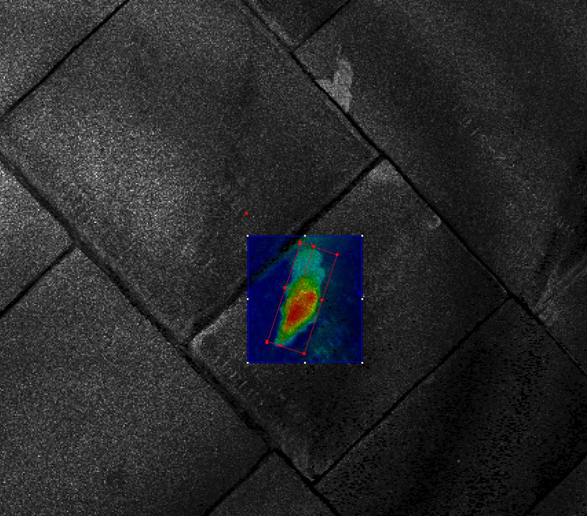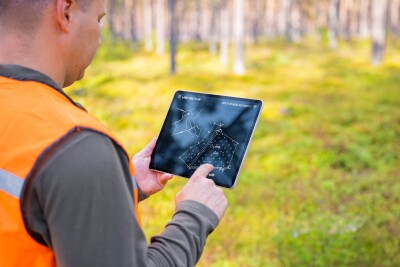The crew of Space Shuttle Discovery used a Laser Camera System (LCS) to scan the shuttle’s protective skin for damage that could imperil re-entry. Built by Neptec Design Group Ltd., Ottawa, ON, the LCS uses a triangulation-based laser scanning technique patented by the National Research Council of Canada (NRC) and has a maximum effective range of 10m. We interviewed Iain Christie, director of R&D at Neptec, as well as executives and technologists at InnovMetric Software Inc. and Raindrop Geomagic, Inc. and reviewed our findings with NASA to understand the role that laser scanning played in safeguarding the STS-114 crew and spacecraft.
“On flight day 2, the first full day in space,” Christie explains, “the shuttle crew inspected the leading edges of the wings and nose cap using the Laser Dynamic Range Imager,” a laser-illuminated video camera from Sandia National Laboratories. “This gave them very precise video imagery.” On flight day 3 as the shuttle approached the International Space Station, the shuttle crew performed the so-called rendezvous pitch maneuver to expose the shuttle’s underside to the space station, so its crew could take 2D photos of the shuttle. “From these and other data sources, NASA compiled a list of so-called Areas Of Interest – AOIs – that merited closer inspection.”
“Most of the AOIs were on the shuttle’s underside, on the tile acreage,” Christie reports. “One was an area on the ‘chine’ of the wing – the fat part where the wing joins the shuttle’s body – near the trailing edge, on the bottom of the wing. Another was on the nose landing-gear door, which was struck by debris during ascent.” Still another was a shuttle component called the external tank door (ETD), which sensor readings indicated might not be fully closed. “The shuttle crew then used our LCS to scan all those AOIs.” geovisit();
Work process for analyzing anomalies: point cloud to LAT to PolyWorks
After scanning with the LCS, the shuttle crew downloaded the raw scan data to NASA, which transferred it to Neptec. “The camera collects data in a spherical coordinate system, so the first step for us is to convert that data into an x,y,z-format point cloud,” according to Christie. “We also have a proprietary software application that searches for damaged areas and performs false-color mapping – LCS Analysis Tool, or LAT.” If this indicates further analysis is needed, “we can then bring the point cloud into one of the InnovMetric tools to perform volume measurement. Then we extract the data indicating the height, width and depth of the damage, and send that to NASA. They then feed that data into their thermal analysis software to check whether the damage is great enough to be of concern.”
In sum, “Our job is to find anything that looks anomalous, and give our estimate of the size of the anomaly. NASA at that point has the freedom to take the data and do any further analysis on it that they need, using whatever software they choose.”
Dr. Marc Soucy, president of InnovMetric Software Inc., St. Foy, QC, reports that InnovMetric’s cooperation with NASA dates back to early 1997, when PolyWorks was intensively used for the Mars Pathfinder Mission. At that time, NASA specialists used PolyWorks to prepare 3D models of the Martian surface for NASA’s web site. “Neptec is a very good partner for us,” Soucy told us. “They have a lot of PolyWorks licenses and advised NASA to use PolyWorks.”
Impact of 3D data
How has response been? “I think NASA is quite pleased with what they’ve been able to see from the 3D data,” Christie reports. “Going into the flight, I’m not sure there was a general acknowledgement of how useful the data would be. NASA was very familiar with 2D data, but I don’t think they were prepared for the completely different level of information you get from 3D. I think it’s won a lot of converts during this mission.” Christie notes the difficulties of accurately interpreting 2D imagery – “You have to ask: Where was the camera angle? What was the lighting condition? And so on. Whereas with 3D, all the data is explicit in the model. Now a manager can look at a file and almost literally stick his finger in the hole and see how big it is.”
“NASA had used 3D scanning on the ground before – the people who work in the CAD/CAM world at NASA were aware of its value,” according to Christie. “But on this flight we’ve shown the mission operations teams that you can use 3D data in real time, and you can make decisions based on it.”
The version of the LCS used on the Space Shuttle Discovery’s return-to-flight mission was developed by Neptec from a scanner originally tested in 2001 on STS-105, according to the Canadian Space Agency. Neptec is a privately held company founded 15 years ago and reports working on more than 25 shuttle missions to date.
The LCS is one component of the new Orbiter Boom and Sensor System (OBSS) developed as an extension to the shuttle’s robotic arm. The Integrated Boom Assembly, a 50-foot-long boom structure, is manufactured by MDA Space Missions, Brampton, ON, and is integrated with sensors at the Kennedy Space Center, according to NASA. The OBSS doubles the reach of the shuttle arm to 100 feet to enable more complete inspection coverage.
Besides Neptec’s LCS, the OBSS also includes a Laser Dynamic Range Imager (LDRI) and an Intensified Television Camera (ITVC). The LDRI, manufactured by Sandia National Laboratories, Albuquerque, NM, consists of an infrared laser illuminator and an infrared camera receiver. The LDRI can be used to provide either 2D or 3D video imagery data, according to NASA – 2D imagery may be seen by the shuttle crew on orbit, while extracting 3D data requires ground processing by NASA. The ITVC is the same low-light black-and-white television camera used in the Space Shuttle’s payload bay. geovisit();
Simulating tile repair with Geomagic Studio
Another software vendor involved with NASA and the shuttle program is Raindrop Geomagic, Inc., Research Triangle Park, NC. According to Ping Fu, chairman, president and CEO, “NASA has been our customer for some time. We began work on this project about nine months ago.” Fu told us, “Our software is being used to process scans taken during the STS-114 mission, and we are on call to NASA 24/7 during the entire flight.”
The objective, according to Fu, is to simulate tile repair in order to be more certain of quality and safety. This objective is supported by enabling NASA ground personnel to recreate damaged shuttle tiles, then physically test the new repair techniques developed after the Columbia disaster. “They want to determine on the ground whether the fix they have available on the shuttle will work. It is the first time that NASA can detect, repair, and validate a repair to ensure safety in an unpredictable environment.”
According to Rob Black, senior application engineer and NASA account manager at Geomagic, the image shown above was created as part of a demonstration the company gave NASA some five months ago. What was the work process? “We took NASA’s point cloud [captured from a damaged tile]and created a polygon model from it using Geomagic Studio.” In this demonstration, Black notes the physical tile sample that NASA scanned did not have gap filler between the tiles, “so we filled those holes in the dataset in order to generate a single continuous polygon model. From there we used our software to automatically lay out a patch structure over the polygon model, then automatically fit a NURBS surface through those patches. Then we exported that surface data to a CAM application and generated a toolpath.”
According to Black, during the Discovery mission, shuttle tiles were scanned and the resulting point clouds were relayed to Houston, where NASA built a surface model in Geomagic Studio and exported the model to Pro/ENGINEER, then to CAM for toolpath generation. Fortunately, damage to the tiles was minor, and NASA did not need to use the toolpath code to cut duplicate damaged tiles.
Fu reports her company will have a role in post-flight shuttle processing as well. “Shuttle tiles cost $6000 apiece, and in flight many become deformed. Repair of each tile is one-of-a-kind, and our software will be used to recreate replacement tiles to fit.”geovisit();






